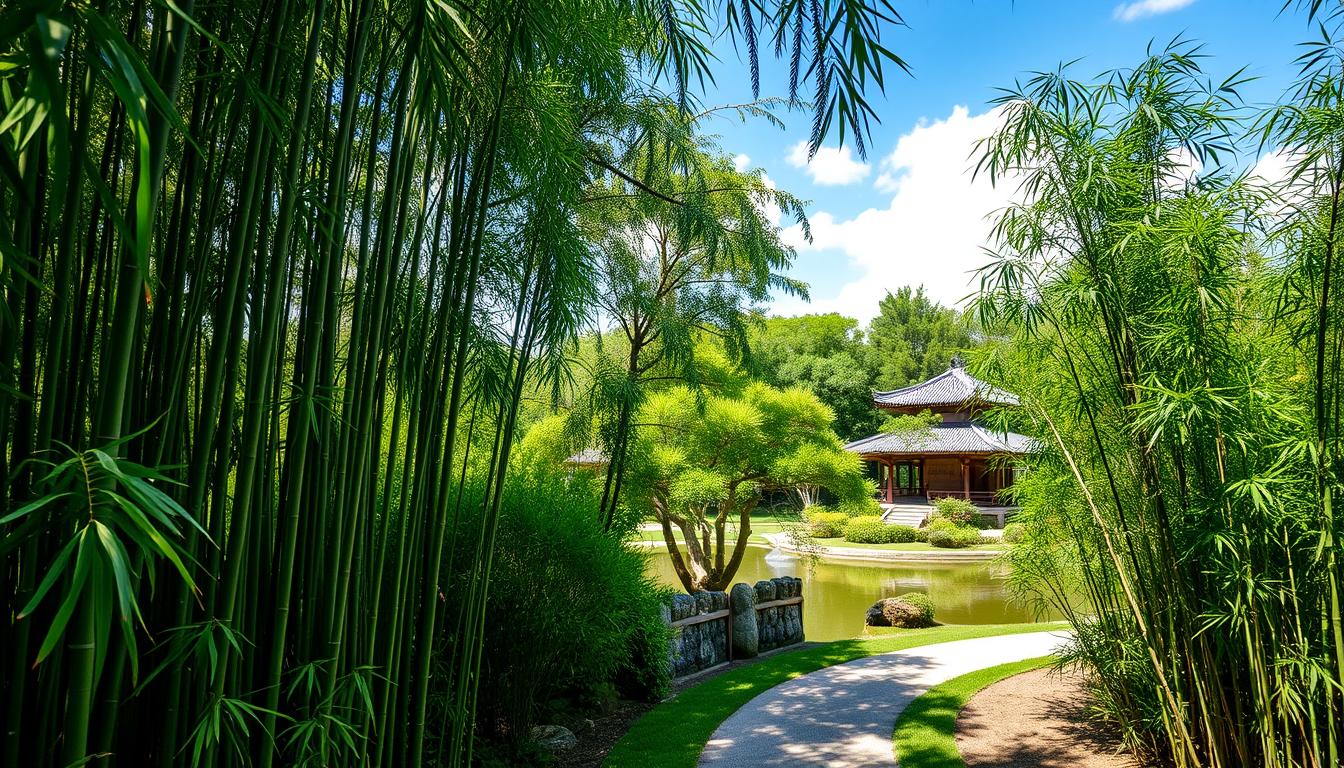Imagine having a serene and eco-friendly outdoor space that not only adds beauty to your yard but also helps reduce your carbon footprint. Bamboo garden ideas can make this a reality, offering a unique and sustainable way to enhance your landscape. With its rapid growth rate, bamboo can be harvested in as little as 3-5 years, making it an attractive alternative to traditional hardwoods. Bamboo landscaping is also incredibly versatile, allowing you to create everything from bamboo plants and trellises to fencing and decorative features.

One of the most significant advantages of bamboo is its durability and lightweight nature, making it perfect for do-it-yourself projects. Bamboo plants can thrive in a variety of conditions, and with proper care, they can provide a natural privacy screen, allowing some light to filter through while keeping your outdoor space secluded. Whether you’re looking to create a peaceful retreat or a functional outdoor area, bamboo garden ideas can help you achieve your goals.
Table of Contents
The Benefits of a Bamboo Garden
Bamboo gardens offer a unique combination of eco-friendly landscaping, natural beauty, and low maintenance. By incorporating bamboo fencing and other bamboo elements, gardeners can create a sustainable outdoor space that not only looks great but also helps to protect the environment.
One of the key benefits of bamboo gardening is its ability to provide natural privacy screens. Bamboo plants can grow quickly and densely, making them an ideal choice for creating a private and secluded outdoor space. Additionally, bamboo gardening tips can help gardeners make the most of their bamboo plants, from choosing the right species to maintaining and pruning them.

Eco-friendly landscaping is another major benefit of bamboo gardens. Bamboo is a highly renewable resource that can be harvested every 3-5 years without harming the plant. This makes it an attractive alternative to traditional landscaping materials, which can have a significant environmental impact. By choosing bamboo fencing and other eco-friendly options, gardeners can reduce their carbon footprint and create a more sustainable outdoor space.
| Benefits of Bamboo Gardens | Description |
|---|---|
| Natural Privacy Screens | Bamboo plants can grow quickly and densely, making them an ideal choice for creating a private and secluded outdoor space. |
| Eco-Friendly Landscaping | Bamboo is a highly renewable resource that can be harvested every 3-5 years without harming the plant. |
| Low Maintenance | Bamboo gardens require less maintenance than traditional gardens, making them a great choice for busy gardeners. |
By following these bamboo gardening tips and incorporating eco-friendly landscaping into their outdoor space, gardeners can create a beautiful and sustainable bamboo garden that provides a peaceful retreat from the stresses of everyday life.
Choosing the Right Bamboo Species
When it comes to selecting bamboo plants for your garden, it’s essential to consider the different types of bamboo species and their unique characteristics. Bamboo plants can be categorized into two main types: clumping and running bamboo. Clumping bamboo species grow in a more contained manner, with new shoots emerging close to the plant’s base, making them less invasive. On the other hand, running bamboo varieties typically spread aggressively through underground rhizomes, becoming invasive if not controlled.
In the United States, different hardiness zones support various types of bamboo species. For cold climates, Fargesia species such as Fargesia murielae and Fargesia nitida are frost-tolerant. In temperate climates, Phyllostachys aurea and Phyllostachys nigra can endure varying weather conditions and handle occasional cold snaps. Warm climates favor Bambusa oldhamii and Bambusa vulgaris, which are tolerant of heat and humidity. Understanding these differences is crucial in choosing the right bamboo species for your garden, as it will affect the plant’s growth and maintenance requirements.
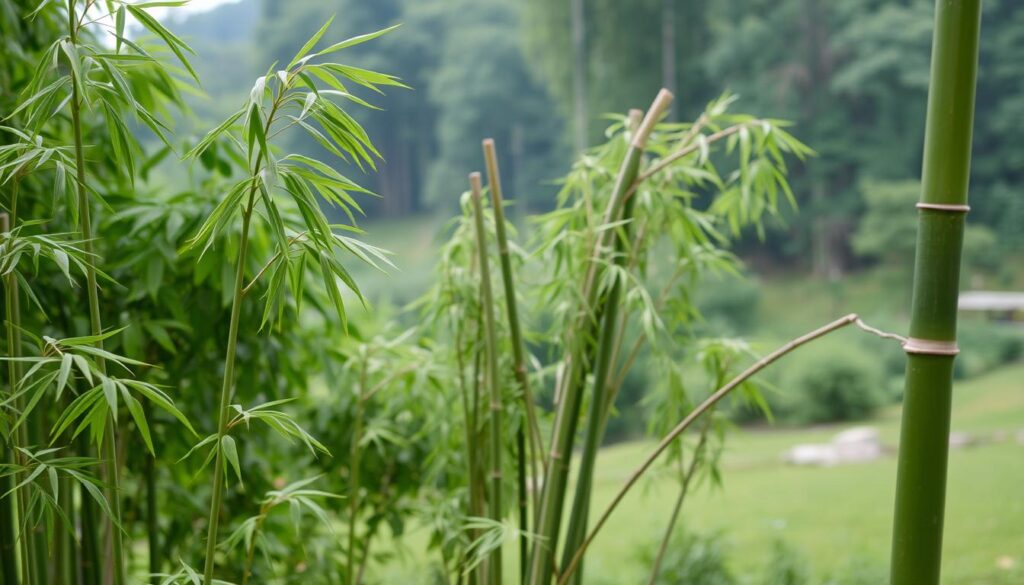
- Fargesia robusta for cold and wet climates
- Phyllostachys nigra for temperate climates
- Bambusa tulda for warm and dry regions
It’s also important to consider the soil requirements for bamboo plants, as they thrive in soil with a pH level range of 5.5 to 7.0 and require well-draining soil to avoid waterlogged conditions. By selecting the right bamboo species and providing the appropriate care, you can enjoy the many benefits of bamboo plants in your garden.
Designing Your Bamboo Garden
When it comes to designing a bamboo garden, there are several factors to consider, especially for small space gardening. Bamboo garden design can be tailored to fit any space, from a small backyard to a large landscape. To create a peaceful and serene outdoor space, consider incorporating bamboo plants into your design, which can help create a natural screen or define different areas of the garden.
In zen gardens, bamboo is often used to create a sense of calm and tranquility. By incorporating bamboo into your garden design, you can create a unique and peaceful outdoor space that promotes relaxation and well-being. Some popular design ideas for small space gardening include using bamboo to create a natural fence or screen, or incorporating bamboo plants into a container garden.
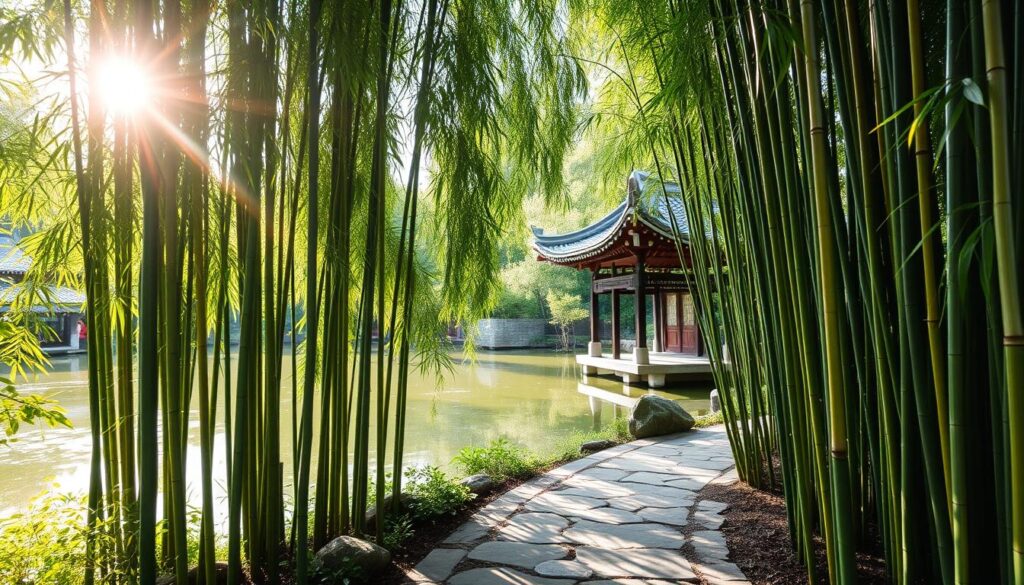
For a more traditional zen garden design, consider incorporating bamboo with other plants, such as moss or ferns, to create a lush and peaceful landscape. By choosing the right plants and design elements, you can create a beautiful and serene outdoor space that reflects the principles of zen gardens.
Bamboo Garden Care and Maintenance
To keep a bamboo garden thriving, proper care and maintenance are essential. This includes regular watering, fertilizing, pruning, and pest management. Bamboo garden care involves understanding the specific needs of the plants, such as watering them 2-3 times a week in the initial months and deep watering every 2-4 weeks during dry spells.
For bamboo maintenance, it’s crucial to prune the plants correctly. Pruning should be limited to removing no more than one-third of the grove or screen per year to maintain health and growth. The recommended pruning period is after new culms mature in late summer, avoiding the spring through early summer when new shoots are produced. This helps in preventing pest management issues, as unhealthy plants are more susceptible to pests.
Pest management is another critical aspect of bamboo garden care. Common problems include scale, mealybugs, and aphids, but these pests seldom cause harm. Control measures involve using insecticidal soap if they emit bothersome amounts of honeydew. Regular inspection and maintenance can help prevent these issues, ensuring the bamboo plants remain healthy and continue to provide benefits for years to come.
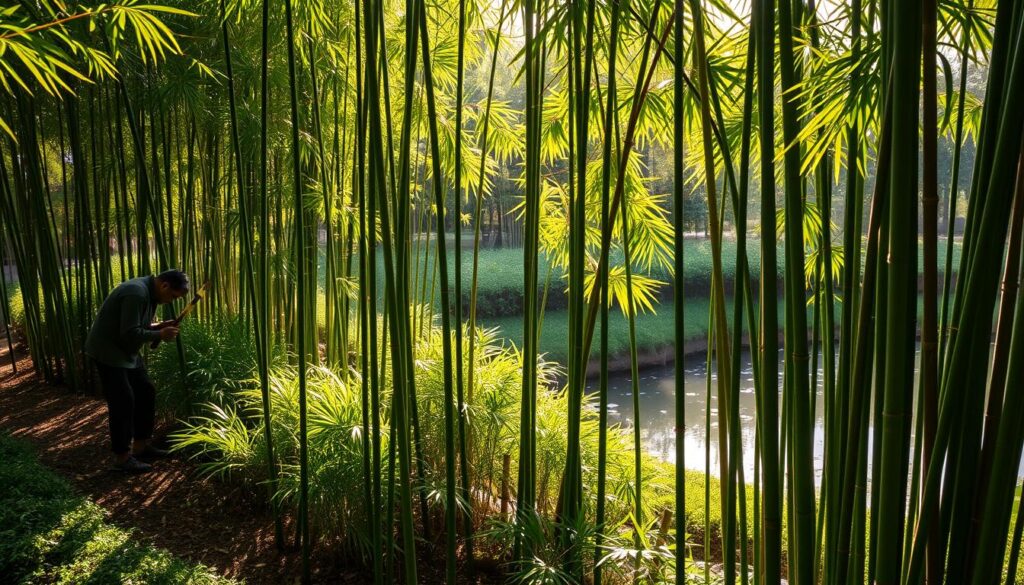
- Watering newly planted bamboo 2-3 times a week in the initial months
- Fertilizing with nitrogen-rich options at the onset of spring
- Pruning correctly to maintain health and growth
- Implementing pest management strategies to prevent issues
By following these tips and understanding the specific needs of the plants, gardeners can create a thriving bamboo garden that requires minimal bamboo maintenance and pest management, ensuring the plants remain healthy and continue to provide benefits for years to come.
| Bamboo Species | Harvesting Age | Growth Rate |
|---|---|---|
| Phyllostachys edulis “Moso” | 3-5 years | 5-10 inches per year |
| Fargesia | 3-5 years | 5-10 inches per year |
Common Misconceptions About Bamboo
Bamboo is often surrounded by myths and misconceptions, including its invasiveness and maintenance requirements. One of the most common bamboo myths is that it is highly invasive and will take over a garden. However, this is not entirely true. While some species of bamboo can spread quickly, many are well-behaved and can be easily controlled with regular pruning.
Another misconception is that bamboo requires a lot of maintenance. In reality, bamboo is a relatively low-maintenance plant that can thrive with minimal care. Regular pruning is necessary to maintain its shape and promote healthy growth, but this can be done with simple tools and techniques. Understanding bamboo invasiveness and longevity is crucial to debunking these myths and appreciating the benefits of bamboo in gardening.
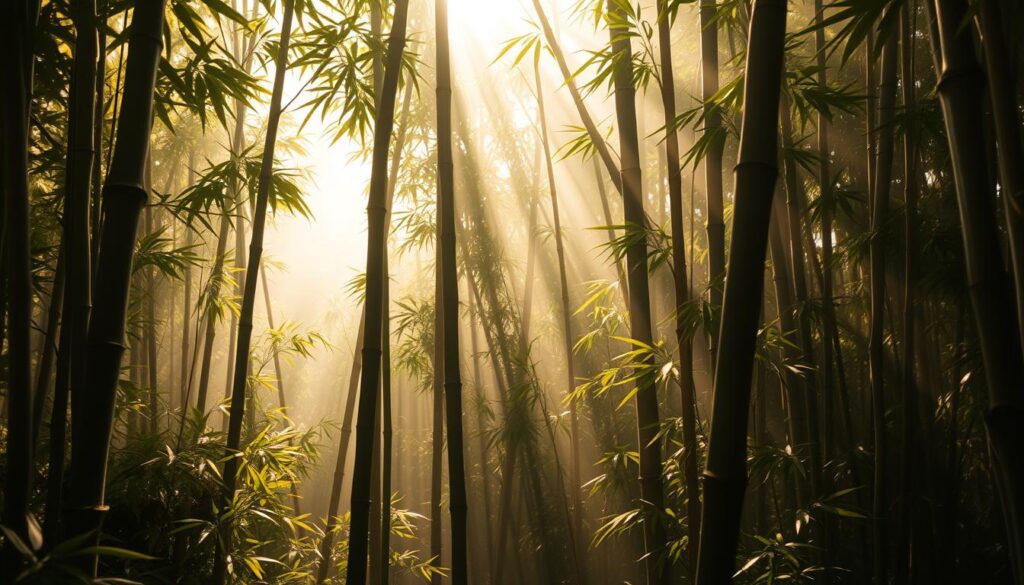
- Bamboo can grow up to 91 cm per day in optimal conditions
- Regular pruning can reduce the density of bamboo clumps by up to 30%
- Bamboo can produce 35% more oxygen compared to the same area of trees
By understanding the facts about bamboo and its characteristics, gardeners can make informed decisions about using bamboo in their gardens and avoid common mistakes. This includes recognizing the importance of bamboo longevity and maintenance requirements to ensure the plant thrives and remains a beautiful and sustainable addition to any garden.
| Bamboo Species | Growth Rate | Height |
|---|---|---|
| Clumping Bamboo | Up to 30 cm per day | Up to 10 meters |
| Running Bamboo | Up to 60 cm per day | Up to 20 meters |
Creating a Bamboo Garden in Your Backyard
To start a bamboo garden, it’s essential to consider soil preparation and sunlight conditions. With over 1,400 species of bamboo, choosing the right one for your garden can be overwhelming. However, by understanding the basics of bamboo planting, you can create a thriving garden.
Here are some tips for creating a bamboo garden:
- Choose a location with the right amount of sunlight, as some bamboo species require full sun to partial shade.
- Prepare the soil by adding a 2- to 3-inch layer of compost or organic matter to retain moisture.
- Water new bamboo plants once a day until they are established.
A well-planned bamboo garden can provide beauty and benefits for years to come. By following these tips and considering factors like bamboo planting, soil preparation, and sunlight conditions, you can create a unique and thriving garden.
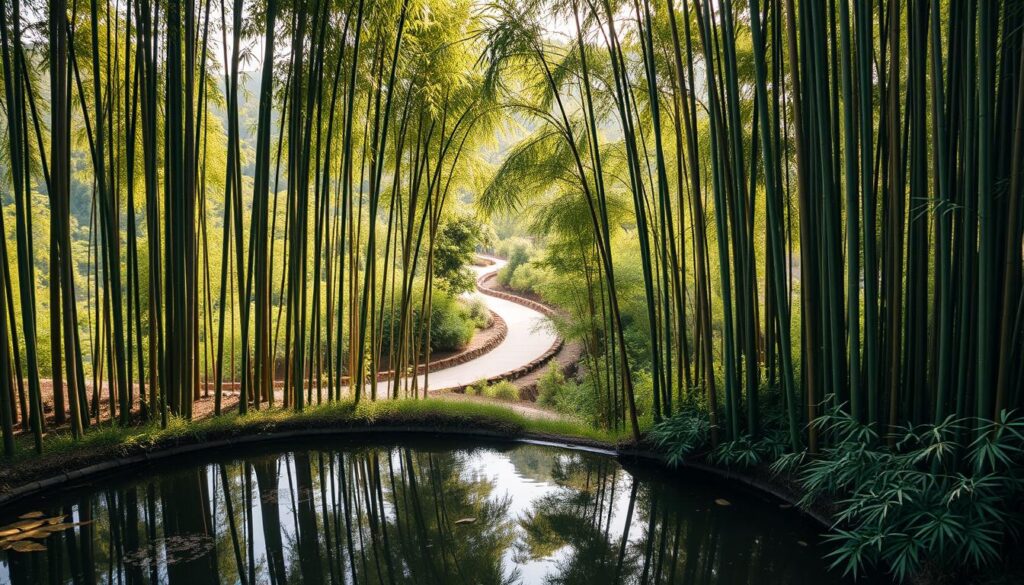
| Bamboo Species | Growth Rate | Sunlight Requirements |
|---|---|---|
| Golden Bamboo | Up to 70 feet tall | At least 6 hours of direct sunlight |
| Fargesia Clumping Bamboo | 2-12 inches per year | Partial shade to full sun |
Using Bamboo in Landscaping
Bamboo is a versatile and sustainable material that can be used in various aspects of landscaping, including bamboo fencing, pathways, and borders. When it comes to bamboo landscaping, the possibilities are endless, from creating a natural border to designing a peaceful water feature.
One of the most popular ways to use bamboo in landscaping is to create a fence. Bamboo fencing is a great alternative to traditional fencing materials, as it is durable, low-maintenance, and eco-friendly. It can be used to create a natural border, separate different areas of the garden, or even as a decorative element.
In addition to fencing, bamboo can also be used to create pathways and borders. Bamboo plants can be used to line a path, creating a natural and inviting walkway. They can also be used to create a border, separating different areas of the garden and adding a touch of natural beauty.
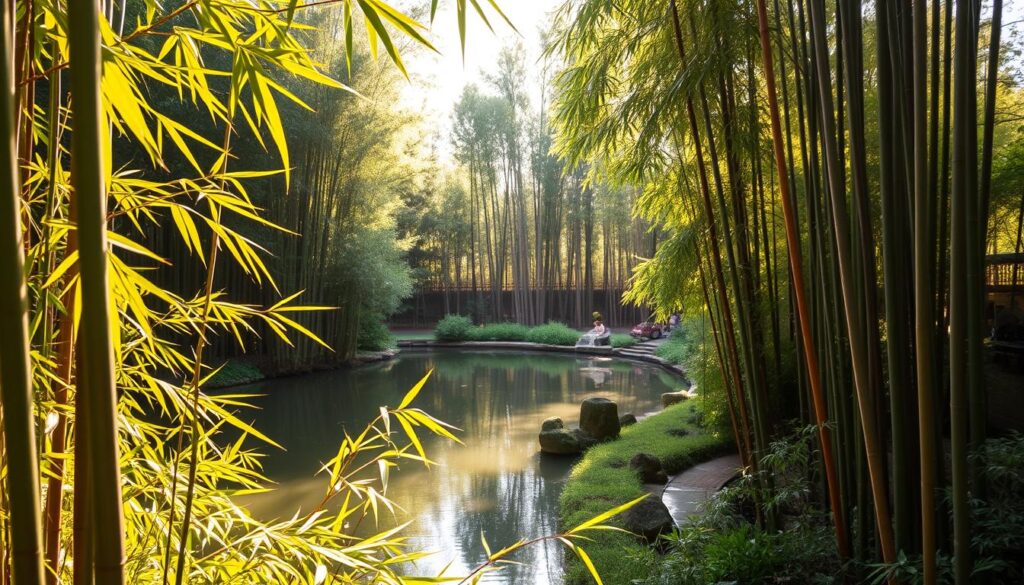
Bamboo can also be used to create water features, such as ponds, waterfalls, and fountains. The sound of running water and the sight of bamboo plants swaying in the breeze can create a peaceful and serene atmosphere, perfect for relaxation and meditation.
| Bamboo Landscaping Ideas | Description |
|---|---|
| Bamboo Fencing | Creating a natural border or decorative element |
| Bamboo Pathways | Creating a natural and inviting walkway |
| Bamboo Water Features | Creating a peaceful and serene atmosphere |
Overall, bamboo is a great material to use in landscaping, offering a range of benefits and possibilities. Whether you’re looking to create a natural border, a peaceful water feature, or simply add some natural beauty to your garden, bamboo is definitely worth considering.
Bamboo Garden Décor and Accessories
Bamboo garden decor and accessories can elevate your outdoor space, providing a natural and serene ambiance. With the right bamboo planters, you can add a touch of elegance to your garden. Bamboo planters come in various sizes, from small pots to large planters, allowing you to choose the perfect fit for your space.
For those looking to incorporate more bamboo into their garden decor, bamboo furniture is a great option. Bamboo furniture is not only eco-friendly but also durable and lightweight, making it easy to rearrange your outdoor space as desired. Whether you prefer a modern or traditional look, bamboo furniture can blend seamlessly into your garden design.
Plant Holders and Pots
- 1-gallon, 5-gallon, 15-gallon, and 25-gallon planter pots available
- Custom-made 36″ tall planter boxes built to individual length specifications
The Use of Bamboo in Garden Furniture
Bamboo furniture is perfect for creating a peaceful seating area in your garden. You can choose from a variety of pieces, including chairs, benches, and swings, to create a tropical atmosphere that enhances your outdoor experience.
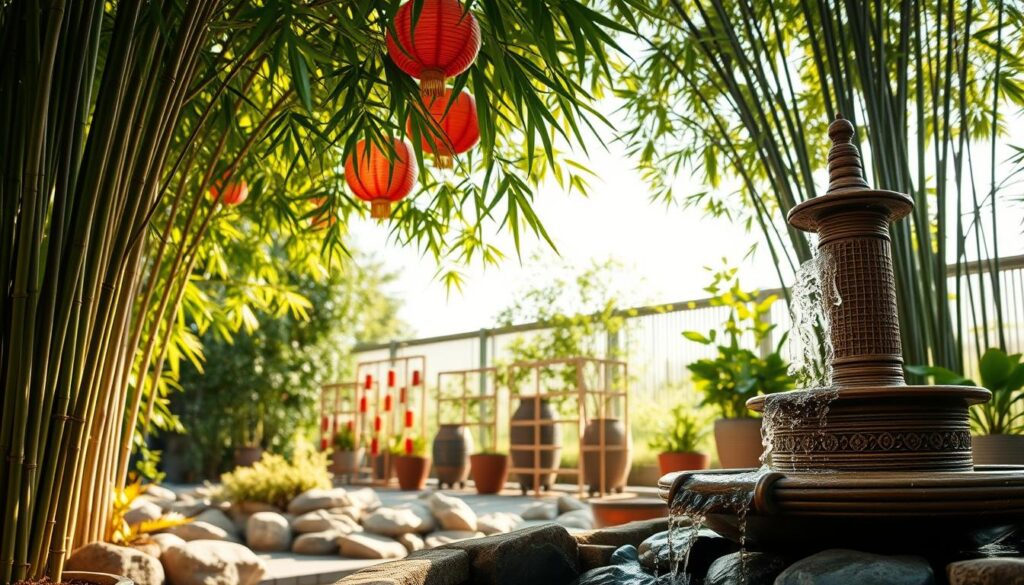
Decorative Features for Aesthetic Appeal
In addition to planters and furniture, bamboo can be used to create decorative features such as walls for showers, birdhouses, windchimes, and outdoor lighting. These elements can increase the perceived privacy of your outdoor space while adding to its aesthetic appeal.
| Decorative Feature | Description |
|---|---|
| Bamboo Birdhouses | Allow for increased capacity for bird food storage |
| Bamboo Windchimes | Provide a soothing sound compared to metal alternatives |
| Outdoor Bamboo Lighting | Aligns with eco-friendly trends while enhancing aesthetic appeal |
The Future of Bamboo in American Gardens
As the demand for sustainable and eco-conscious gardening practices continues to grow, bamboo is poised to play an increasingly significant role in American gardens. Trends in the horticulture industry indicate a shift towards more environmentally friendly landscaping solutions, with homeowners and gardeners seeking out plants that offer both aesthetic appeal and tangible benefits for the environment.
Trends in Sustainable Gardening
Bamboo’s versatility, rapid growth, and carbon-absorbing capabilities make it an attractive choice for those seeking to create sustainable outdoor spaces. The growing interest in native and drought-tolerant plants, as well as the desire to reduce the use of synthetic fertilizers and pesticides, aligns perfectly with the low-maintenance and eco-friendly nature of bamboo.
Bamboo’s Role in Eco-Conscious Practices
Beyond its use in traditional landscaping, bamboo is also finding its way into innovative eco-conscious practices, such as the construction of sustainable fencing, decking, and even furniture. As homeowners and designers become more aware of the environmental impact of their choices, the versatility and renewable nature of bamboo make it an increasingly attractive option for a wide range of garden applications.
FAQ
What are the benefits of using bamboo in gardening?
Bamboo is a durable, sustainable, and aesthetically appealing choice for gardening. It has a rapid growth rate and can thrive in a variety of conditions, making it an ideal option for creating unique and eco-friendly outdoor spaces.
How can bamboo be used in landscaping and garden design?
Bamboo can be used to create natural privacy screens, control soil erosion, and add a touch of natural beauty to your garden. It can be incorporated into landscaping designs in various ways, such as using bamboo fencing to define different areas or using bamboo plants to create a peaceful water feature.
What are the different types of bamboo and how do I choose the right one for my garden?
There are two main types of bamboo: clumping and running. Clumping bamboo is better suited for ornamental purposes, while running bamboo is more effective for erosion control. When choosing a bamboo species, consider factors like hardiness zones, growth characteristics, and the specific needs of your garden.
How can I design a bamboo garden that promotes relaxation and well-being?
Incorporating bamboo into your garden design can create a peaceful and serene outdoor space. Consider using bamboo plants to create natural screens, integrating them with other plants, or using them to define different areas of your garden for a zen-like atmosphere.
How do I care for and maintain a bamboo garden?
Proper care and maintenance are key to keeping your bamboo plants healthy and thriving. This includes watering and fertilizing, pruning techniques, and implementing effective pest management strategies. By following these guidelines, you can ensure your bamboo garden continues to provide benefits for years to come.
What are some common misconceptions about bamboo, and how can I avoid them?
There are several myths about bamboo, such as its invasiveness, longevity, and high maintenance requirements. By understanding the facts about bamboo, you can make informed decisions and avoid common mistakes when incorporating it into your garden.
How do I create a bamboo garden in my backyard?
Creating a bamboo garden in your backyard involves proper soil preparation, selecting the right location with the appropriate sunlight conditions, and following a step-by-step planting guide. By taking the time to prepare and plant your bamboo correctly, you can ensure a thriving and sustainable garden for years to come.
What are some innovative ways to use bamboo in my garden and landscaping?
Bamboo can be used in a variety of creative ways in your garden and landscaping, such as bamboo fencing, pathways and borders, and unique water features. By exploring these options, you can create a truly one-of-a-kind outdoor space that reflects your personal style and preferences.
How can I incorporate bamboo into my garden décor and accessories?
Bamboo can be used to create a wide range of garden décor and accessories, from plant holders and pots to furniture and decorative features. By incorporating bamboo into your garden décor, you can add a natural and sustainable touch to your outdoor space.
What is the future of bamboo in American gardens?
The future of bamboo in American gardens is promising, as the demand for sustainable and eco-conscious gardening practices continues to grow. Bamboo’s role in promoting eco-friendly landscaping and creating a better future for the environment is likely to become increasingly prominent in the years to come.
Source Links
- 20 Creative Bamboo Backyard Ideas to Transform Your Outdoor Space – Sustain Life Journal – https://sustainlifejournal.com/bamboo-backyard-ideas-2/
- Summertime Bamboo Gardening: Creative Ideas and DIY Tips | Bamboo Grove – https://www.bamboogrove.com/blog/bamboo-uses/summertime-bamboo-gardening-creative-ideas-and-diy-tips/
- 5 Benefits of Having a Japanese Bamboo – https://greg.app/japanese-bamboo-benefits/
- Growing Together: Cultivating Community Through Urban Bamboo Gardens | Bamboo Grove – https://www.bamboogrove.com/blog/bamboo/growing-together-cultivating-community-through-urban-bamboo-gardens/
- Sustainable Garden Ideas: Embracing Bamboo for Eco-Friendly Gardening – https://www.ukbamboo.com/blog/garden-ideas-using-our-new-bamboo-garden-range/
- Bamboo Basics: Choosing the Right Type for Your Climate and Soil – Suan Sook Homestay Bed and Breakfast – https://suansook.com/bamboo-basics-choosing-the-right-type-for-your-climate-and-soil/
- Bamboo Variety Guide: Simplifying Your Species Selection Process – Canada’s Bamboo World – https://www.bambooworld.com/bamboo-variety-guide/
- Make Japanese Bamboo Fences & Trellises | Gardener’s Supply – https://www.gardeners.com/how-to/diy-bamboo-fences-and-trellises/5162.html?srsltid=AfmBOopfs_WdvptA_PCGt01OX5ajvWryPVFKnv0WLp9XwQFIPnJiqAgw
- How to Grow and Shape Lucky Bamboo – https://www.thespruce.com/growing-lucky-bamboo-1902994
- Bamboo Grove Maintenance & Thinning | Bamboo Garden – https://www.bamboogarden.com/resource-pages/bamboo-grove-maintenance-thinning
- How to Grow and Use Bamboo in Your Garden: A Detailed Guide – Tips and How To – https://spicymoustache.com/how-to-grow-and-use-bamboo-in-your-garden-a-detailed-guide/
- How To Grow And Care For Bamboo – https://www.southernliving.com/garden/perennials/how-to-grow-bamboo?srsltid=AfmBOopLUaXUGQTGwEtF0Zlh9nx0Yc8deCmYLLDTe55qOxo7NCilg54d
- Containment | Almaville Bamboo Co. – https://abcbamboo.com/containment/
- Why choose bamboo? – Tanzania Forest and Beekeeping Services – https://www.forestbeekeeping.co.tz/2024/02/16/why-choose-bamboo/
- About Bamboo – BambooSahiHai India India – https://bamboosahihai.com/about-bamboo/
- Learn About Bamboo Types Before Planting to Avoid Problems – https://www.bhg.com/gardening/trees-shrubs-vines/shrubs/bamboo-gardening/
- How to grow bamboo – https://www.gardenersworld.com/how-to/grow-plants/how-to-grow-bamboo/
- Make Japanese Bamboo Fences & Trellises | Gardener’s Supply – https://www.gardeners.com/how-to/diy-bamboo-fences-and-trellises/5162.html?srsltid=AfmBOorCOBvzldi56nM9dWwtOnv8_-izax8bahkhiaC31DYbugUjh0WT
- Growing and Using Your Own Bamboo – Backwoods Home Magazine – https://www.backwoodshome.com/growing-and-using-bamboo-on-the-homestead/
- How to use Bamboo to Create an Asian Landscape Design – https://bambooplantsonline.com/blogs/blog/54233732-how-to-use-bamboo-to-create-an-asian-landscape-design?srsltid=AfmBOorVe5F6sIhJqClI5isa7U0FocEk5CsUtpI4EMLnEjMdwPwxn6MZ
- Bamboo Giant Nursery & Gardens – https://www.bamboogiant.com/
- Why November is the Perfect Month for Planting Bamboo | Bamboo Grove – https://www.bamboogrove.com/blog/bamboo-news/why-november-is-the-perfect-month-for-planting-bamboo/
- A small garden? you can still play bamboo – RDK Landscaping – https://rdklandscaping.com/a-small-garden-you-can-still-play-bamboo/

